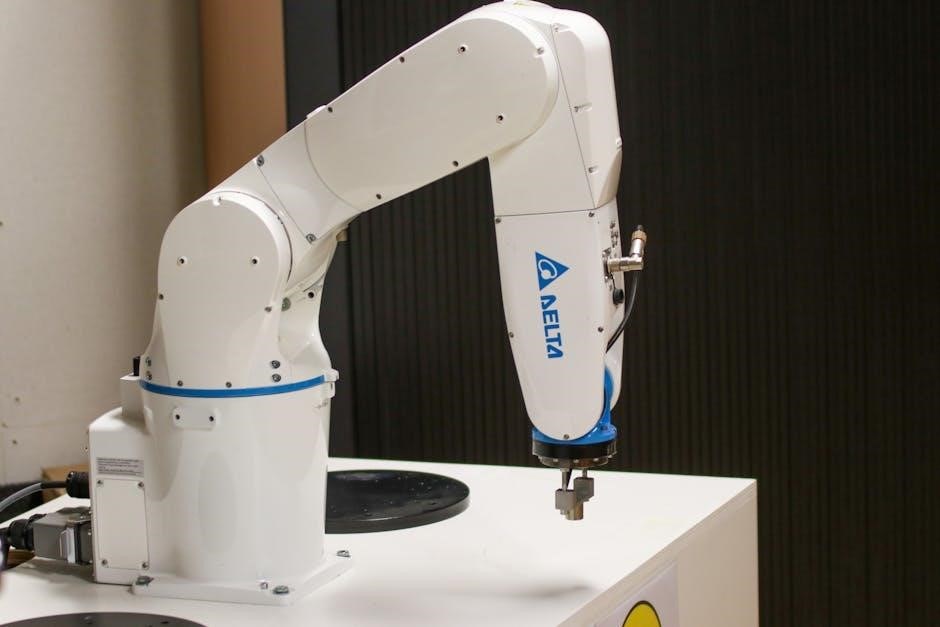Welcome to the DSC Neo Programming Manual, your comprehensive guide to installing, configuring, and troubleshooting the PowerSeries Neo alarm system. This manual provides clear instructions and tips to help you maximize the system’s potential, ensuring optimal security and functionality for your needs.
Overview of DSC Neo System
The DSC Neo system, part of the PowerSeries Neo line, is a feature-rich and reliable intrusion alarm control panel designed for scalability and integration with various compatible components. It supports up to 8 zones on the main control panel, expandable via hardwire, wireless, addressable modules, and keypad zones. The system includes 2 partitions, a 128-event buffer, and 2 on-board PGM outputs, expandable to 14 with additional modules. It offers advanced programming methods, including installer programming, DLS software, and wireless configurations, making it versatile for both residential and commercial applications. The Neo system integrates seamlessly with keypads, zone expanders, and other modules, ensuring a customizable security solution. Its user-friendly interface and robust features make it a popular choice for modern security needs. Proper installation and configuration, as outlined in the manual, are essential for optimal performance and functionality.
Importance of the Programming Manual
The DSC Neo Programming Manual is an essential resource for installers, technicians, and users to understand and utilize the full potential of the system. It provides detailed step-by-step instructions for configuring, programming, and maintaining the Neo system, ensuring proper functionality and security. The manual covers critical aspects such as zone configuration, user code management, and system customization, making it indispensable for both initial setup and ongoing adjustments. It also includes troubleshooting guides and error code explanations, helping users resolve issues efficiently. Regular updates and best practices outlined in the manual ensure the system remains secure and performs optimally. By following the manual, users can avoid common pitfalls, ensure compliance with safety standards, and maximize the system’s features for their specific needs. This comprehensive guide is vital for anyone working with the DSC Neo system to achieve a seamless and reliable security setup.

Installation and Setup
The DSC Neo system requires careful preparation and precise installation to ensure optimal performance. Start by verifying compatibility with existing hardware and checking power supply requirements. Mount the control panel securely, ensuring all wiring connections are correct and tightly secured. Follow the manual’s guidelines for initializing the system and performing the first power-up test. This step is crucial for identifying potential issues early. Proper installation ensures reliability, ease of use, and maximum security. Always refer to the manual for specific instructions tailored to your setup. A well-executed installation is the foundation of a smooth and efficient system operation.
Planning the Installation
Planning is critical for a successful DSC Neo installation. Begin by assessing the location for the control panel, ensuring it is central and accessible. Evaluate power supply requirements and identify a reliable source. Consider the layout of sensors and zones to maximize coverage and efficiency. Verify compatibility with existing systems and hardware to avoid integration issues. Plan wiring routes carefully to minimize exposure and interference. Create a detailed wiring diagram to guide the installation process. Identify potential obstacles, such as structural barriers or signal interference, and develop solutions. Plan for future expansion by leaving room for additional zones or features. Review the manual to ensure compliance with safety and installation standards. A well-planned installation ensures a smooth and efficient setup process, reducing the risk of errors or downtime. Proper preparation is essential for optimal system performance and reliability.
Wiring and Hardware Setup
Proper wiring and hardware setup are essential for the DSC Neo system to function correctly. Begin by connecting the control panel to the power supply, ensuring all wires are securely fastened. Use high-quality, shielded cables to minimize interference. Connect sensors and zones according to the wiring diagram, verifying polarity and termination. Install keypads, motion detectors, and other peripherals in strategic locations. Use the correct gauge wire for long runs to prevent voltage drop. Ground the system properly to avoid electrical noise and ensure reliable communication. Test all connections before powering on the system. Use cable ties or clips to organize wires neatly. Double-check wiring configurations to match the system’s requirements. Proper hardware installation ensures optimal performance, reliability, and safety. Always refer to the manual for specific wiring instructions and safety precautions to avoid damage or malfunction.

Programming Methods
The DSC Neo system offers flexible programming methods to suit various installation needs, ensuring efficient setup and customization for optimal security solutions.
Installer Programming
Installer programming is the foundation of setting up the DSC Neo system, enabling professionals to configure the security setup according to specific requirements. This process involves defining zones, user access levels, and system responses to various events. The DSC Neo programming manual provides detailed guidance on using the keypad, remote access tools, and software interfaces to streamline the installation process. Key steps include setting up zone definitions, assigning zones to areas, and configuring advanced features like motion detection sensitivity and alarm triggers. Installers can also integrate third-party modules, such as alarm.com for remote monitoring. Proper programming ensures reliable performance, minimizing false alarms and maximizing security effectiveness. Regular updates and adherence to best practices are recommended to maintain system integrity and functionality. Always refer to the official manual for precise instructions tailored to the DSC Neo system.
Advanced Programming Techniques
Advanced programming techniques for the DSC Neo system allow experienced users to tailor the security configuration to meet complex requirements. These techniques include creating custom macros for multi-step actions, configuring advanced zone types, and setting up conditional logic for event responses. The DSC Neo programming manual provides in-depth guidance on utilizing these features to enhance system functionality. Users can leverage advanced user access controls, such as multi-level permissions and custom user profiles, to ensure secure operation. Integration with third-party devices, like smart home systems, can also be programmed for seamless functionality. These techniques require a strong understanding of the system architecture and are recommended for professionals or advanced users. By mastering these methods, users can unlock the full potential of the DSC Neo system, ensuring a highly customized and efficient security solution.

Key Features of DSC Neo
The DSC Neo system offers advanced security solutions, smart home integration, and a user-friendly interface, providing customizable controls and remote access for enhanced convenience and safety.
User Interface and Navigation
The DSC Neo system features an intuitive and user-friendly interface designed to simplify navigation and operation. The interface provides clear, organized menus and easy-to-understand controls, making it accessible for both beginners and experienced users. Customizable dashboards allow users to prioritize frequently used functions, while the responsive design ensures seamless interaction. The system’s navigation is streamlined, with logical grouping of features and quick-access shortcuts. This enhances efficiency and reduces the learning curve for new users. Additionally, the interface supports multiple languages and offers visual feedback for actions, ensuring clarity and precision. The intuitive layout minimizes errors, making it easier to configure settings or monitor system status. Overall, the user interface and navigation of the DSC Neo system are designed to deliver a smooth, hassle-free experience, catering to a wide range of user needs and preferences.
Zone Control and Configuration
The DSC Neo system provides robust zone control and configuration options, enabling precise customization to meet specific security needs. Zones can be defined based on area, type, or function, with options for intrusion, fire, and access control zones. Each zone can be configured with unique settings, such as sensitivity levels, alarm responses, and notification triggers. Advanced features include zone partitioning, allowing multiple zones to operate independently within a single system. Customizable zone attributes ensure tailored functionality, while user-friendly tools simplify the configuration process. The system also supports cross-zoning, enabling coordinated responses between multiple zones. With intuitive programming, users can easily assign devices, set thresholds, and define actions for each zone. These features ensure a highly adaptable and efficient security solution, catering to diverse residential and commercial requirements. The zone control capabilities of the DSC Neo system are designed to enhance security and flexibility.

Troubleshooting Common Issues
Identify and resolve common issues with the DSC Neo system using diagnostic tools and error messages. Address connectivity problems, sensor malfunctions, and system resets effectively for optimal performance.
Error Codes and Solutions
The DSC Neo system displays specific error codes to identify issues, ensuring quick resolution. Common codes include E001 for power supply problems, E002 for communication failures, and E003 for sensor malfunctions. Refer to the manual for detailed solutions.
For E001, check the power cables and ensure the system is properly connected to a stable power source. Reset the system after correcting the issue.
If E002 appears, verify all wiring connections and ensure the control panel is communicating with peripheral devices. Restart the system to test connectivity.
Address E003 by inspecting sensors for damage or misalignment. Clean or replace faulty sensors, then perform a system test to confirm resolution.
Always refer to the manual for a comprehensive list of codes and step-by-step solutions to maintain system functionality and security. Regular updates may also resolve recurring issues.
System Maintenance and Updates
Regular system maintenance is crucial for optimal performance and security. The DSC Neo system requires periodic updates to ensure compatibility with the latest features and security patches. Always download firmware updates from the official DSC website to avoid unauthorized modifications.
Before updating, back up your system configuration to prevent data loss. Use the backup and restore feature in the installer menu. After updating, test all zones and devices to ensure functionality.
Inspect wiring and connections regularly to prevent wear and tear. Clean sensors and detectors to maintain accuracy. Replace batteries in wireless devices as recommended by the manufacturer.
Refer to the manual for detailed update instructions and maintenance schedules. Regular checks ensure reliable operation and extend the system’s lifespan. Always follow safety guidelines during maintenance to avoid system downtime.

Best Practices for Optimal Use

Always follow the manual guidelines, test configurations thoroughly, and train users for seamless operation. Regular updates and proper system checks ensure reliability and performance. Adhere to security protocols. Regular maintenance prevents issues and enhances functionality. Train users to understand system features and troubleshooting basics. Consistent monitoring and timely adjustments optimize performance. Familiarize yourself with error codes for quick resolution. Keep backup configurations for easy recovery. Plan system expansions carefully to maintain compatibility. Document all changes for future reference. Test zones and devices after programming. Use genuine DSC parts for reliability. Review user activity logs for insights. Update software regularly for new features and security patches. Inspect wiring and connections periodically. Replace batteries in wireless devices as needed. Schedule routine maintenance to prevent downtime. Consult the manual for troubleshooting common issues. Ensure all users understand emergency procedures. Keep the system firmware up-to-date. Monitor system performance regularly. Log all system changes and updates. Train new users on basic operations. Review system logs for anomalies. Test all features after updates. Backup configurations before making changes. Follow manufacturer guidelines for hardware installation. Secure access to programming menus. Document all user credentials. Test alarm responses regularly. Inspect sensors for proper alignment. Replace worn-out components promptly. Update user access levels as needed. Monitor battery levels in devices. Review system settings after updates. Test communication pathways regularly. Keep the system clean and dry. Backup critical data frequently. Follow safety guidelines during maintenance. Consult professionals for complex issues. Log all maintenance activities. Test remote access functionality. Inspect power supplies for stability. Replace outdated software promptly. Monitor user activity for compliance. Test all zones after changes. Backup system settings regularly. Follow local regulations and standards. Consult the manual for advanced features. Test all devices after updates. Inspect wiring for damage. Replace faulty components immediately. Update system firmware regularly. Monitor system health daily. Log all user interactions. Test alarm systems monthly. Backup data before updates. Follow best practices for security. Consult the manual for troubleshooting. Test all features after maintenance. Inspect sensors for accuracy. Replace batteries as needed. Update software for security patches. Monitor system performance. Log all changes and updates. Test zones and devices. Backup configurations. Follow guidelines for optimal use. Consult professionals if unsure. Test all functions after updates. Inspect hardware regularly. Replace worn parts. Update firmware. Monitor system health. Log activities. Test alarms. Backup data. Follow manual instructions. Consult support for issues. Test after changes. Inspect wiring. Replace batteries. Update software. Monitor performance. Log updates. Test zones. Backup settings. Follow best practices. Consult manual. Test functionality. Inspect devices. Replace parts. Update firmware. Monitor system. Log changes. Test alarms. Backup data. Follow guidelines. Consult support. Test after updates. Inspect hardware. Replace components. Update software. Monitor health. Log activities. Test zones. Backup configurations. Follow manual. Consult professionals. Test functionality. Inspect wiring. Replace batteries. Update firmware. Monitor performance; Log updates. Test alarms. Backup settings. Follow best practices. Consult manual. Test after changes. Inspect sensors. Replace parts. Update software. Monitor system. Log changes. Test zones. Backup data. Follow guidelines. Consult support. Test functionality. Inspect hardware. Replace components. Update firmware. Monitor health. Log activities. Test alarms. Backup configurations. Follow manual. Consult professionals. Test after updates. Inspect wiring; Replace batteries. Update software. Monitor performance. Log updates. Test zones. Backup settings. Follow best practices. Consult manual. Test functionality. Inspect sensors. Replace parts. Update firmware. Monitor system. Log changes. Test alarms. Backup data. Follow guidelines. Consult support. Test
Security Considerations
Ensure strong passwords are set for all user accounts to prevent unauthorized access. Enable encryption for wireless communications to safeguard data transmission. Regularly update firmware to patch security vulnerabilities. Restrict access to programming menus using secure credentials. Use tamper-evident wiring to deter physical breaches. Implement user authentication for critical system functions. Monitor access logs to detect suspicious activities. Disable unused ports and services to minimize exposure. Conduct regular security audits to identify weaknesses. Train users on best practices to avoid common security mistakes. Use secure protocols for remote system access. Protect backup configurations with strong encryption. Regularly test security measures to ensure effectiveness. Consider implementing biometric authentication for enhanced security. Keep sensitive system information confidential. Never share access codes with unauthorized individuals. Always verify user identities before granting access. Regularly review and update security protocols to stay ahead of threats.

Regular System Checks
Perform regular system checks to ensure optimal performance and reliability. Inspect battery health and wiring connections to prevent power issues. Test all zones and sensors for proper functionality. Check event logs for unusual activity or potential faults. Verify that all alarm triggers and responses are working correctly. Ensure communication links, such as cellular or IP connectivity, are stable. Review user codes and access levels to maintain security. Test backup power systems to confirm they activate during outages. Inspect motion detectors and cameras for clear visibility and accuracy. Schedule periodic tests of alarm sirens and strobes. Update system firmware to ensure compatibility and functionality. Check for loose connections or worn-out components that may cause malfunctions. Perform a full system test monthly to identify and address issues early. Maintain a record of checks and updates for future reference and compliance. Regular checks help prevent unexpected failures and ensure continuous protection.

Additional Resources
Explore official DSC Neo websites, online forums, and technical support for comprehensive guides. Utilize video tutorials, FAQs, and user communities for enhanced understanding and troubleshooting. Additional resources are readily available online.
Downloading the Manual
To obtain the DSC Neo Programming Manual in PDF format, visit the official DSC website or authorized distributors. Navigate to the support or resources section, where downloadable materials are available. Enter “DSC Neo Programming Manual” in the search bar to locate the PDF quickly. Ensure the file is downloaded from a trusted source to avoid malware risks. Some websites may require registration or verification before accessing the manual. For convenience, use search engines with specific queries like “DSC Neo Programming Manual PDF” to find direct links. Always verify the document’s authenticity by cross-referencing with official DSC documentation. This ensures you have the most up-to-date and accurate information for programming and configuring your DSC Neo system effectively.
Online Tutorials and Guides

Supplement your understanding of the DSC Neo system with online tutorials and guides available on various platforms. Official DSC websites and authorized training partners offer comprehensive video tutorials, step-by-step guides, and interactive modules. These resources are designed to help users master both basic and advanced programming techniques. YouTube channels dedicated to security systems often feature detailed walkthroughs of DSC Neo configurations. Additionally, forums and community discussions provide real-world insights and troubleshooting tips shared by experienced users. Many online guides are updated regularly to reflect the latest system updates and features. Take advantage of these resources to enhance your proficiency in using the DSC Neo programming manual effectively. They are particularly useful for visual learners and those who prefer hands-on instruction beyond written documentation.

